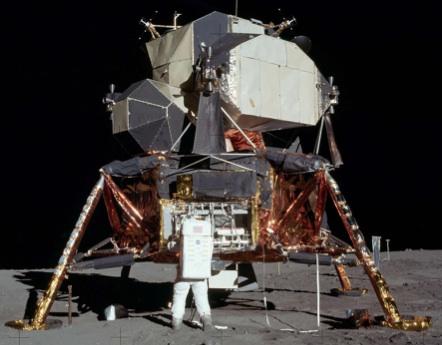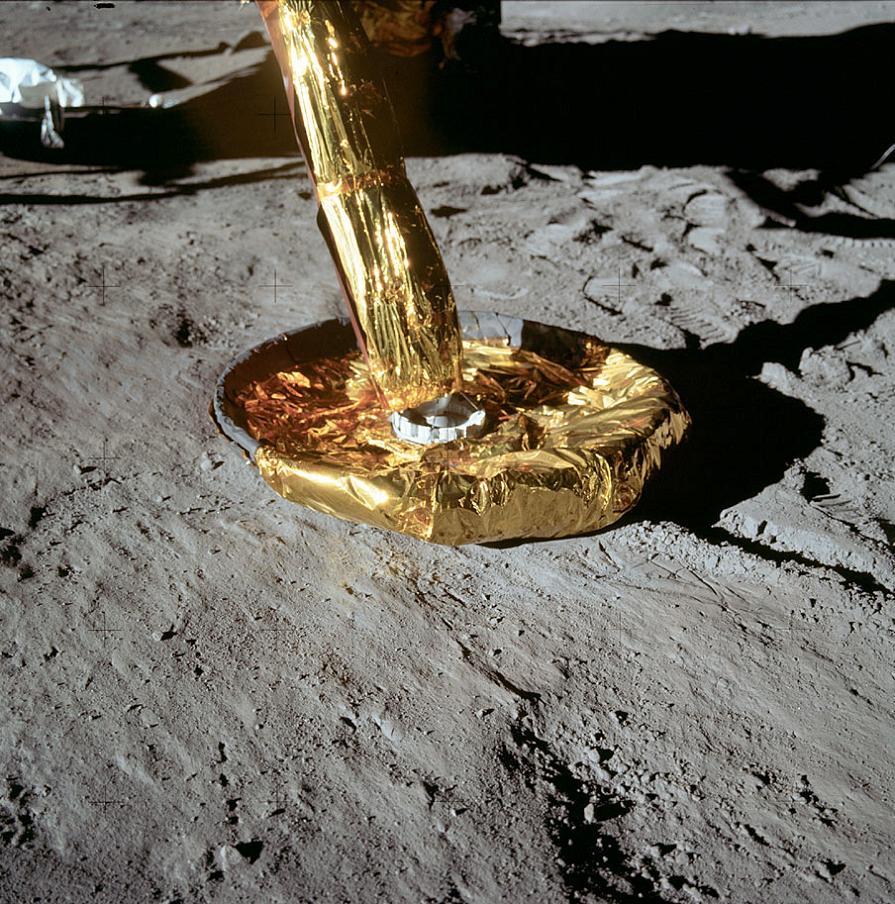2011 Moon Dust UPDATE: See Dr. Walt Brown's brief summary and then his careful analysis of how much dust should be on a four-billion year old moon. (A lot more than is there.) And see Terry Hurlbut's great article, The moon-dust argument might be valid after all. Dr. Brown's calculations are based on actual data and seriously challenges the Answers in Genesis warning that creationists should not use the moon dust argument.
2014 AiG Update: On February 13, Ken Ham blogged about his great debate with Bill Nye and listed moon dust among "outdated or discredited" arguments. For years, Real Science Radio has been calling for AiG and other young-earth ministries (who have our love and respect) to either update their decades-old argument to show the public, if they can, where Dr. Brown's assembled data and mathematical calculations are in error, or they should remove moon dust from their "do not use" list. Or, preferably, they themselves should resume using this powerful argument for a young moon!
2015 NASA & AiG Updates: In July 2015 here at RSR we interviewed NASA scientist Henry Richter who's account, below, confirmed the dust concern. That same month we noticed, thankfully, that AiG removed moon dust from their Arguments to Avoid page.
2017 Update: Bob Enyart interviewed astronaut who walked on the Moon, at rsr.org/commander-alan-bean.
* First an Atheist Caller Talks to NASA's Dr. Gold: Welcome to a special edition of Real Science Radio. An atheist caller, Forrest from Hawaii, had previously claimed that he had spoken to a NASA scientist Dr. Thomas Gold, who had personally told him that NASA had no concern about too much dust on the moon. Forrest wanted to use this information to discredit Bob Enyart's account of NASA designing the Lunar Module with large "feet" to prevent it from sinking into dust on the moon.
 * Secondly Retired Engineer Bob Ball Reports His Research & Personal Recollection: Long-time friend of BEL and retired computer engineer Bob Ball from Indiana confirmed through his own research and independent recollection, NASA's serious, though unwarranted, concern in the 1960s that the moon would hold a tremendous amount of dust (because they believed it would have been collecting dust for billions of years, an age, and therefore, a concern, that young-earth creationists would dispute). Ball further recounted that this concern was promoted by NASA's own Dr. Thomas Gold himself, the very man our caller Forrest says that he had spoken to, who allegedly claimed that NASA had no such concern, and especially not when they designed the Lunar Lander.
* Secondly Retired Engineer Bob Ball Reports His Research & Personal Recollection: Long-time friend of BEL and retired computer engineer Bob Ball from Indiana confirmed through his own research and independent recollection, NASA's serious, though unwarranted, concern in the 1960s that the moon would hold a tremendous amount of dust (because they believed it would have been collecting dust for billions of years, an age, and therefore, a concern, that young-earth creationists would dispute). Ball further recounted that this concern was promoted by NASA's own Dr. Thomas Gold himself, the very man our caller Forrest says that he had spoken to, who allegedly claimed that NASA had no such concern, and especially not when they designed the Lunar Lander.
* Atheist Forrest Calls Back: Forrest states that he did not accept Bob Ball's report that Dr. Thomas Gold was the very astronomer who most promoted the unnecessary concern over moon dust.
 * Next Listener Darrell Birkey Quotes NASA: Birkey, of Goshen, Indiana called in to quote from NASA's own website, which states, "astronomer Thomas Gold asserted, however, that the apparently smooth areas on the moon were likely to be covered with a layer of fine dust several meters thick, raising the prospect that the lunar module might sink out of sight..."
* Next Listener Darrell Birkey Quotes NASA: Birkey, of Goshen, Indiana called in to quote from NASA's own website, which states, "astronomer Thomas Gold asserted, however, that the apparently smooth areas on the moon were likely to be covered with a layer of fine dust several meters thick, raising the prospect that the lunar module might sink out of sight..."
So NASA's own historical account (it's own revisionist footnote notwithstanding) agrees with what Bob Enyart surmised on the air, refuting Forrest's first specific criticism of BEL. For NASA itself states, "Spacecraft engineers at Houston's Manned Spacecraft Center, meanwhile, in spite of their real need for this information [how much dust] in designing the lunar landing module, had to go ahead without it [without that data]." That is, NASA was designing the Lunar Module prior to its Ranger and Surveyor missions discovering that the depth of dust on the moon was negligible. So NASA gave the lunar lander large "feet" because they were pressed for time (to fulfill John Kennedy's dream of reaching the moon by the end of the decade) and so they designed the landing features so as to prevent the craft from sinking in dust.
* NASA's Burke & Richter Discuss Moon Dust: The Smithsonian Channel and Real Science Radio have broadcasted interviews with leading NASA scientists documenting the moon dust concern. Henry Richer corrected BEL's mistaken atheist caller (see above) who had been insisting that NASA never feared that the moon might be covered with meters of dust. However, Dr.Richter recalled for RSR the invalid but great concern, arising out of the old-earth worldview, that the Lunar Lander might sink out of site into dust that would have accumulated on the surface of the moon over its alleged billions of years. Additionally, this 3-minute audio excerpt, courtesy of the Smithsonian Channel's Space Voyages: Into the Unknown, presents another NASA scientist, James Burke, explaining that the Surveyor Mission proved that a vehicle could land on the Moon without sinking deep into the dust that evolutionary scientists feared may have been there. Dr. Burke was project manager for the Ranger missions (which preceded Surveyor), and Roger Launius, also heard on this audio clip, is the curator for the Smithsonian's National Air and Space Museum. Determining how much dust had accumulated on the lunar surface was one of the primary goals of the Surveyor program which eventually landed seven robotic craft on the moon. As Burke said, "If Surveyor had sunk in out of sight, then of course there would have been a different course of events." For, contrary to biblical creationism, the evolutionary old-earth mindset had led NASA to fear that the moon may be covered in dust even perhaps dozens of feet deep. See more of the transcript below.
* Anti-Creationist Bias Evident in Revisionist History: Thus, as certainly evident unless heavily biased against any creationist claim, a concern of deep moon dust was still in the minds of NASA engineers when they designed the Lunar Lander's feet, and NASA's own website falsifies Forrest's claim of Dr. Gold's "version."
* Partial Transcript of Smithsonian Space Program: The great program, Space Voyages: Into the Unknown, presents NASA scientist James Burke (voice at :44 and 1:56), project manager for the Ranger missions which preceded Surveyor, and Roger Launius, Curator for the Smithsonian's National Air and Space Museum.
* 2012 Moon Landing Hoax Update: RSR has perhaps the most complete and concise rebuttal of this absurd hoax available anywhere on the web, so check out our RealScienceRadio.com/moon-landing-hoax-refuted!
* Program Note: This BEL show was originally titled: Can't see the Trees for the Forrest.
Also: Indiana Senate candidate Greg Walker opposes abortion and supports flogging for criminals!
